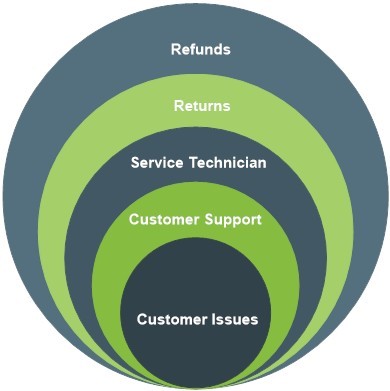The Reverse Logistics Onion
By Robert Gordon, American Public University
Many companies have been making great strides to become more efficient with their reverse logistics operations, seeking out the most efficient and streamlined methods. As important as their pursuit of efficiency, there also needs to be an understanding of reverse logistics at the operational level.
Reverse logistics is about everything that happens after a customer purchases an item. To have a successful reverse logistics operation, the organization needs to understand that at the core, reverse logistics is about addressing customer issues.

To understand this better, think of reverse logistics functions as an onion. All layers of an onion are so tightly pressed together that it appears to be a solid ball. Yet the reality is that each “leaf” is connected only at the base. Each reverse logistics layer might not be directly connected in the organization, but all of them serve to support the customer when designed correctly.
Just as an onion is a single vegetable despite its layers being connected only at the base, the successful organization seamlessly connects all of its reverse logistics operations. And when an organization has all of these functions working together seamlessly, it is successful in the customers’ eyes.
At the core of the reverse logistics onion are the customer and the customer’s issue. If there were no issues, the customer would never engage the reverse logistics. Hence, the customer’s issues are the base that holds the supporting reverse logistics systems together.
The first layer is customer support. Everyone at one point has called tech support or customer relations to report that a newly purchased item is not meeting expectations. Customer support will help the customer troubleshoot the problem. It matters not if the technology is faulty or a user error; customer service must be unfailingly polite and try to assist the customer in gaining full use of their purchase. The most important matter at this layer is being polite and offering real solutions. Customers want to be heard, and they want their problems corrected. If customer support cannot fix the problem, the customer needs to be connected to the next layer.
The customer is directed to the second layer when it appears that the problem is a technology issue. Some companies might have service techs who are sent to the customer site. Other organizations have a tech support group that helps customers virtually. Regardless of the type of support needed, the organization must ensure that the tech support team has the same values and customer-centered view as the customer support team.
If an organization has personnel with excellent tech skills, it is vital to invest in training them to deal with customers. Regardless of the customers’ skill level, they are still people, and they need to be treated with respect and given the support required.
If the tech team cannot resolve the issue, the customer needs to return the item for replacement. This layer is again about respect, but respect translated into speed. The purpose of a return is to get a replacement for the customer as soon as possible. For example, Amazon will ship out a replacement when the faulty or mis-fitting item is returned to a collection point or is picked up in person. The act of promptly shipping out a replacement once the return package is picked up communicates trust, embodies respect and helps speed the returns process.
If it is not possible to return the item, the company must accept the reality of a refund, which is the final layer. Refunds are the least desirable solution, but there are times it is better for the company to move on from the sale. A company must understand that a sale might not remain because a customer might be unhappy and return the product. In addition, a customer that was treated with respect might still come back for another product. Organizations need to be as diligent as possible with all the previous layers to retain as many sales as possible.
Organizations that adopt the reverse logistics onion can help reduce the number of refunds and improve customer satisfaction. Showing respect for customers and ensuring that everything possible to save the sale makes a difference. It’s important to make sure that the entire process is positive because customers can be customers for life.
Research shows that when people buy a brand name and are happy with the product, they will purchase that brand in the future.
Reverse logistics is about preserving the customer relationship rather than just trying to make a single sale. Taking the long view will ensure companies are successful and create satisfied customers who come back for years.
 Robert Gordon
Robert GordonDr. Robert Gordon is the Program Director of the Reverse Logistics Management program at American Public University (APU). RLA has teamed with APU, a leader in online education with a strong track record of working with students in reverse logistics, transportation and logistics, management, and manufacturing sectors. APU has an accredited academic program for a Bachelor’s and Master’s degree in Reverse Logistics. APU developed the program over a decade ago; working with the RLA, APU’s program leads the industry in turning out reverse logistics professionals who can make a difference. APU is offering special discounts for RLA member companies and their employees.